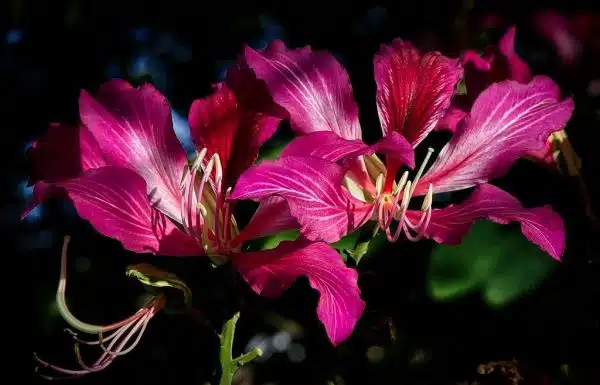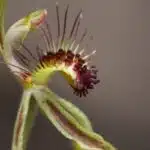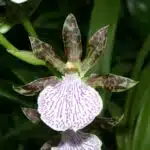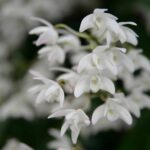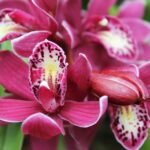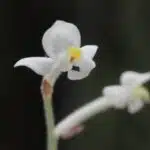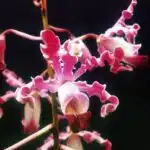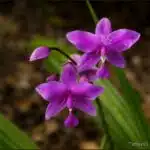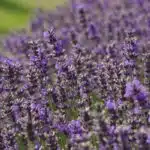Orchids are one of the most admired and sought-after plants in the world. Their vibrant blooms come in a variety of colors, shapes, and sizes, making them a popular choice for decorating homes and gardens. However, many people are unsure how long these beautiful flowers will last before they wilt and fall off.
As an orchid specialist, I have spent years studying these fascinating plants and their blooming patterns. In this article, I will share my insights on the lifespan of orchid blooms, including factors that affect their longevity and tips on how to extend their bloom time. Whether you’re a seasoned orchid enthusiast or simply looking to add some color to your space, understanding how long orchid blooms last can help you make more informed decisions about caring for these stunning plants.
Introduction To Orchids
Orchids are one of the most mesmerizing and elegant flowers in the plant kingdom. They are highly sought after for their striking beauty and exotic nature. With over 25,000 species worldwide, orchids come in a vast range of colors, shapes, and sizes. They can be found growing naturally in almost every corner of the world.
Orchid care is a delicate art that requires attention to detail and patience. These plants require specific environmental conditions to thrive, such as high humidity, bright but indirect sunlight, and well-draining soil. Different species may have slightly different requirements, so it is essential to research the specific needs of each orchid you plan to grow.
Some popular orchid species include Cattleya, Dendrobium, Phalaenopsis, and Vanda. Each has its unique characteristics that make them desirable among orchid enthusiasts. Cattleyas are known for their fragrant blooms, while Phalaenopsis is favored for its ease of care and longevity of blooms. Understanding these differences can help you choose the right orchid for your home or garden. Moving forward into this article’s subsequent section about ‘anatomy of an orchid bloom’ will provide valuable insights into what makes these flowers so fascinating and beautiful.
Anatomy Of An Orchid Bloom
As we explored in the previous section, orchids are some of the most stunning and diverse plants in the world. Orchid blooms are particularly fascinating due to their unique anatomy and the crucial role they play in pollination. However, one question that often arises is how long do these beautiful blooms last?
To answer this question, we must first understand that the lifespan of an orchid bloom depends on several factors. On average, an orchid bloom can last anywhere from a few days to several months. Some species, such as the Phalaenopsis or “moth orchid,” can have blooms that last up to three months, while others may only have blooms that last a few days.
One factor that affects the longevity of an orchid bloom is pollination. Once an orchid has been successfully pollinated, its bloom will begin to wilt and die off. This is because the plant has fulfilled its reproductive purpose and no longer needs its bloom to attract pollinators. Additionally, environmental factors such as temperature and humidity can also impact how long an orchid bloom lasts.
- Factors Affecting Orchid Bloom Longevity:
- Pollination
- Temperature
- Humidity
While understanding how long an orchid bloom lasts is certainly important for those looking to enjoy these beautiful flowers at home or in nature, there are other aspects of these blooms that are equally fascinating – namely their fragrance. In the next section, we will explore the role fragrance plays in attracting pollinators and why it’s so important for successful reproduction in many species of orchids. But first, let’s dive deeper into what causes different types of fragrances in these remarkable flowers.
Factors That Affect Bloom Longevity
As an orchid specialist, I have seen a vast array of factors that can affect the bloom longevity of these beautiful flowers. Two of the most important factors that impact how long an orchid bloom lasts are temperature and light. Orchids are sensitive to both hot and cold temperatures, and if they experience extreme temperature changes, their blooms may fall off prematurely. Similarly, orchids require specific amounts of light to thrive, and if they do not receive enough sunlight or too much direct sunlight, this can shorten the lifespan of their blooms.
To ensure that your orchid blooms last as long as possible, there are methods you can employ to prolong their life. One common method is misting – this involves spraying the leaves and blooms with water to keep them hydrated without overwatering them. Another technique is pruning – removing dead flowers or stems from the plant encourages new growth and extends the blooming period. By employing these techniques along with monitoring temperature and light conditions, you can optimize the lifespan of your orchid blooms.
While it’s essential to consider these general factors when caring for your orchids, it’s also important to note that different species may have unique bloom durations. In our next section, we will explore species-specific differences in bloom duration and how this knowledge can help you tailor your care routine accordingly.
Species-Specific Differences In Bloom Duration
The duration of orchid blooms varies among different species. Orchids are known for their spectacular flowers, but the bloom longevity factors depend on several factors such as genetics, environmental conditions and care. Some orchids produce flowers that last for months, while others have blooms that last only a few days.
Species comparison is an essential aspect of studying orchid bloom duration. For instance, some species like Phalaenopsis have blooms that can last up to three months if cared for correctly. On the other hand, Cattleya orchids typically have blooms that last between one and two weeks. Similarly, Dendrobium orchids can have flowers that last up to six weeks or more.
Here are four examples of how different species compare in terms of bloom longevity:
- Vanda: The flowers usually last about two to three weeks.
- Oncidium: The flowers can last anywhere from 4-8 weeks.
- Cymbidium: Blooms generally last from 4-10 weeks.
- Paphiopedilum: Flowers can persist for up to 6-8 weeks.
In conclusion, understanding the species-specific differences in bloom duration is crucial when selecting an orchid plant to grow at home or in a greenhouse setting. Factors such as genetics and environmental conditions influence flower longevity significantly. In the next section, we will explore some of the environmental factors that affect bloom length so that you can provide your orchids with optimal growing conditions for extended blooming periods.
Environmental Factors That Affect Bloom Length
Metaphorically speaking, orchid blooms are like the stars in the sky–beautiful to behold but fleeting. As an orchid specialist, it is important to understand how various environmental factors can impact the length of time that these stunning blooms last. Factors affecting bloom length include light intensity, temperature fluctuations, and humidity levels.
Light intensity is a critical factor affecting bloom length. Orchids require specific lighting conditions to thrive and produce healthy blooms. Insufficient light can cause weak stems and small flowers, while too much light can scorch leaves and burn buds before they have a chance to open fully. It is important to note that different varieties of orchids have unique requirements for optimal lighting conditions.
Temperature fluctuations also play a significant role in determining how long an orchid bloom lasts. Most species prefer warm temperatures during the day and cooler temperatures at night. Sudden changes in temperature, especially if they are drastic or prolonged, can damage delicate flowers and shorten their lifespan significantly.
Humidity levels are another crucial factor affecting orchid bloom colors and duration. Higher humidity levels promote healthy growth by helping plants retain moisture and reducing water loss through transpiration. When humidity levels drop too low, flowers may wilt prematurely or lose their vibrant colors more quickly than usual.
Understanding these factors will help you create optimal growing conditions for your orchids to thrive and produce long-lasting, vibrant blooms. In the next section, we will discuss common mistakes that can shorten bloom time and how to avoid them.
Common Mistakes That Can Shorten Bloom Time
Understanding the environmental factors that affect bloom length is essential for orchid enthusiasts. However, it’s just as important to avoid common mistakes that can shorten bloom time. One of the most common mistakes is overwatering. Orchids are susceptible to root rot, which can quickly kill the plant and its blooms. To prevent this, make sure you’re using a well-draining potting mix and only water your orchid when the top inch of soil is dry.
Another mistake that can shorten bloom time is not providing enough light. Orchids need plenty of bright, indirect sunlight to thrive, but direct sunlight can scorch their delicate leaves and flowers. If you notice your orchid isn’t blooming as long as it should be, try moving it to a brighter spot or supplementing with artificial light.
Troubleshooting tips for extending orchid bloom time include pruning back spent blooms and ensuring proper fertilization. Pruning can encourage new growth and more blooms while too much fertilizer can actually harm your orchid’s roots and reduce blooming potential. Instead, opt for a balanced fertilizer specifically formulated for orchids and follow the manufacturer’s instructions carefully.
To care for orchids and extend their bloom time, it’s crucial to pay attention to environmental factors while avoiding common mistakes like overwatering and inadequate lighting. By taking proactive steps like pruning spent blooms and properly fertilizing your plant, you can enjoy beautiful blooms for longer periods of time.
How To Care For Orchids To Extend Bloom Time
Orchid bloom care is essential to prolonging blooms and ensuring that your orchids thrive. By providing the right conditions and care, you can extend the life of your orchid blooms significantly. Proper lighting, temperature, and humidity are critical factors in keeping your orchids healthy.
Lighting is an essential aspect of caring for orchids. Too much light can cause sunburns on leaves, while too little can prevent blooms from developing correctly. Orchids require bright but indirect light, which can be achieved by placing them near a window with sheer curtains or using artificial lights. Temperature and humidity are also crucial in creating the ideal environment for your orchids. Orchids prefer temperatures between 60-80°F during the day and slightly cooler at night. Humidity levels should be around 50-70%, which can be achieved by using a humidifier or placing a tray of water near your orchids.
Regular maintenance such as watering and fertilizing orchids is essential to maximize their blooms. Watering should be done when the top inch of soil feels dry to the touch, and it’s best to use room temperature water to avoid shocking the roots. Fertilizing should be done once a month with a balanced fertilizer specifically formulated for orchids. With proper care, your orchid blooms can last up to several months, delighting you with their beauty for an extended period.
Watering And Fertilizing Orchids For Maximum Blooms
- Proper watering and fertilizing of orchids is essential for optimal bloom quality and duration.
- The frequency of watering depends on the variety of orchid and the potting material used.
- Generally, a low-nitrogen fertilizer should be used for orchids, as this helps promote flowering and bloom longevity.
- The amount of fertilizer used depends on the type of fertilizer, and should be applied according to the manufacturer’s instructions.
- Over-fertilizing or under-watering can reduce the number of blooms and shorten the bloom duration.
- Proper care and maintenance of orchids can result in blooms that last up to several months.
Watering Frequency
As an orchid specialist, it is important to understand the impact that watering techniques have on the longevity of orchid blooms. Proper watering frequency ensures that blooms remain hydrated throughout their lifespan, leading to a longer-lasting and visually appealing display.
Watering frequency should be determined by several factors, including the type of orchid and its environment. As a general rule of thumb, most orchids require watering every 7-10 days during warmer months and every 10-14 days during cooler months. However, this may vary depending on the specific needs of each individual plant.
Bloom hydration is crucial for maintaining the vibrancy and longevity of orchid blooms. Avoid over-watering, as this can lead to root rot and ultimately cause blooms to wilt prematurely. On the other hand, insufficient hydration can cause blooms to become dehydrated and dry out quickly. Consistently monitoring soil moisture levels and adjusting watering frequency accordingly will help ensure healthy blooms for weeks or even months at a time.
Fertilizer Types
To ensure the optimal growth and longevity of orchids, it is essential to apply proper fertilization techniques in addition to regular watering. As an orchid specialist, I understand that selecting the right type of fertilizer and timing its application is critical for maximizing blooms.
One important consideration when choosing a fertilizer is whether to use organic or synthetic options. Organic fertilizers are derived from natural sources and are often slower-acting but more sustainable over time. Synthetic fertilizers, on the other hand, are chemically formulated and provide faster results but can potentially harm beneficial microorganisms in the soil. Each option has its benefits, and it ultimately depends on personal preference and growing conditions.
The timing of fertilizer application is also crucial for healthy orchid blooms. Generally, fertilizing should occur during periods of active growth or just before blooming to ensure adequate nutrient availability. However, it is essential not to over-fertilize as this can lead to root damage and other issues. Consistent monitoring of plant health and adjusting fertilizer application accordingly will help optimize bloom production without causing undue stress or damage to the plant.
Fertilizer Amount
As an orchid specialist, I understand the importance of proper fertilization techniques in achieving maximum blooms. In addition to selecting the right type of fertilizer and timing its application, it is equally crucial to consider the appropriate amount of fertilizer to use for optimal growth and longevity.
The amount of fertilizer used should be balanced carefully to avoid over-fertilization, which can lead to root damage and other issues. Applying too much fertilizer can also cause nutrient imbalances that may affect plant health negatively. Orchids have unique nutrient requirements that vary throughout their life cycle; thus, it is essential to monitor plant health regularly and adjust fertilizer application accordingly.
Optimal timing is also critical when determining the amount of fertilizer needed for healthy orchid blooms. Fertilizer should be applied during periods of active growth or just before blooming when nutrient availability is crucial. Over-applying or under-applying fertilizers during these stages may result in reduced bloom production or stunted growth. Therefore, consistent monitoring of plant health and adjusting fertilizer application according to their needs will help achieve a perfect balance between nutrient availability and optimal bloom production without causing undue stress or damage to the plant.
Repotting Orchids To Encourage Blooms
As an orchid specialist, I can confidently say that repotting benefits the overall health and bloom production of orchids. When an orchid outgrows its pot or the potting mix begins to break down, it can lead to root rot and hinder proper nutrient absorption. Repotting allows for fresh potting mix to be added, which provides essential nutrients and aeration to the roots.
When selecting a potting mix for repotting, there are several options available. The most common option is bark-based mixes, which provide excellent drainage and aeration. Another option is sphagnum moss-based mixes, which hold moisture well and are great for orchids that require high humidity levels. It is important to choose a potting mix based on the specific needs of your orchid species.
Repotting should be done during the dormant season when growth is minimal. It is recommended to repot every 1-2 years or when necessary due to overcrowding or poor drainage. Providing optimal growing conditions through repotting can encourage healthy root growth and ultimately lead to better bloom quality. In the next section, we will discuss another important step in encouraging optimal orchid bloom quality: pruning.
Pruning Orchids For Better Bloom Quality
Correct pruning techniques are essential for ensuring the best quality of blooms produced by orchids. Pruning should involve removing spent blooms, old roots, and dead leaves. Proper pruning of an orchid will improve the overall quality of the blooms produced, as well as their duration. For optimal bloom quality, pruning should be done regularly in order to maintain healthy growth and flowering.
Correct Pruning Techniques
As an orchid specialist, I understand how much joy these flowers bring to their owners. However, it is important to note that pruning is necessary to maintain the health of the plant and ensure better bloom quality. Pruning frequency depends on the type of orchid and its growth rate. Generally, it is recommended to prune once a year or when the stem begins to yellow.
When pruning orchids, it is essential to use the right tools for the job. The best pruning tool for orchids is a pair of sharp, sterile scissors or pruning shears. This prevents damage to the plant and reduces the risk of infection. Sterilizing your tools before use helps prevent the spread of disease between plants.
Correct pruning techniques are crucial in maintaining healthy orchids with long-lasting blooms. When cutting back stems, make sure to cut above a node or “eye” where new growth will occur. Avoid trimming too close to healthy leaves as this can cause stress on the plant. Following these tips will ensure that your orchids continue to produce beautiful blooms year after year.
Bloom Quality Improvement
As an orchid specialist, one of the most common questions I receive is about improving bloom quality. While pruning plays a vital role in maintaining healthy plants, it also promotes better blooms. Proper bloom care and enhancement are crucial for any orchid owner who wants their plant to produce vibrant and long-lasting flowers.
One way to improve bloom quality is by removing spent flowers regularly. This process called deadheading encourages the plant to produce new blooms. Deadheading should be done carefully using sterile scissors or pruning shears to prevent damage to the stem or infection. By deadheading regularly, you can help your orchids focus on producing more beautiful and healthy blooms.
Another method that can significantly impact bloom quality is fertilizing. Fertilizers provide essential nutrients that promote healthy growth and flower production. However, it’s essential not to over-fertilize as this can harm the plant instead of enhancing it. A balanced fertilizer recommended for orchids will ensure proper nutrition without causing damage or stress on the plant.
In conclusion, pruning orchids is not only necessary for maintaining their health but also important for achieving better bloom quality. With proper bloom care and enhancement techniques such as deadheading and fertilizing, you can ensure your orchids continue producing beautiful flowers year after year. As an orchid specialist, my goal is always to help enthusiasts serve their plants’ needs effectively and efficiently while enjoying the beauty they bring into our lives.
Orchid Bloom Colors And Their Meanings
Pruning orchids is an essential step in enhancing their bloom quality. However, once the blooms emerge, it’s natural to wonder how long they will last. The lifespan of orchid blooms varies depending on the species and environmental conditions.
Some orchid blooms can last for several weeks while others may only last for a few days. Factors such as temperature, humidity, and light intensity can affect their longevity. In general, warmer temperatures and higher humidity levels can shorten the bloom lifespan, while cooler temperatures and lower humidity levels can extend it.
Orchid blooms have significant cultural significance and symbolism in different parts of the world. In ancient Greece, they represented virility and fertility. In China, they were associated with wealth and good fortune. The Aztecs believed that the scent of orchids could induce strength and power in warriors.
- Orchid blooms come in a wide range of colors from white to pink to purple to red.
- Some orchid species produce fragrant flowers while others are scentless.
- The shape of orchid blooms ranges from round to star-shaped to spider-like.
- Orchids also differ in size, with some producing small delicate flowers while others have large showy ones.
Understanding the various aspects of orchid bloom symbolism and cultural significance adds a deeper layer of appreciation for these stunning plants. In the next section, we’ll explore another aspect of orchid blooms: their shapes and sizes.
Orchid Bloom Shapes And Sizes
One common misconception about orchid blooms is that they all look the same. However, this couldn’t be further from the truth. Orchid bloom shapes and sizes vary greatly depending on the variety, making them one of the most diverse flower species in existence. Identifying different varieties can be a challenge for even seasoned growers, but there are techniques available to make identification easier.
To better understand the diversity of orchid blooms, it’s helpful to compare them with other flower species. Orchids have evolved over time to develop unique bloom shapes and sizes that aid in attracting pollinators, such as bees and butterflies. This has resulted in an incredible range of forms and colors that make orchids some of the most sought-after plants for collectors and hobbyists alike.
When it comes to identifying orchid blooms, there are several key factors to consider. These include the overall shape of the bloom, the size of its petals and sepals, and any unique markings or patterns on the flower itself. By paying close attention to these details, growers can better appreciate the incredible diversity of these stunning plants.
As we delve deeper into understanding orchid bloom shapes and sizes, it’s important to also explore their life cycle and reproductive processes. By doing so, we can gain a greater appreciation for these fascinating plants’ growth habits and how best to care for them throughout their lifecycle.
Orchid Bloom Cycle And Reproduction
Orchids are one of the most popular plants in the world, prized for their exotic beauty and diverse shapes and sizes of blooms. In the previous section, we discussed the various shapes and sizes of orchid blooms. Now, let us delve into another important aspect of orchid biology: their bloom cycle and reproduction.
Orchids have a unique reproductive strategy that involves insect pollination and seed dispersal. Unlike other plants that rely on wind or birds for pollination, orchids have evolved intricate mechanisms to lure specific insects to their blooms. The shape, color, and scent of an orchid flower are precisely tailored to attract a particular species of insect. Orchids produce nectar as a reward for these insects’ services; in return, they transfer pollen from one flower to another.
Once pollinated, an orchid will produce a seed pod that contains thousands of tiny seeds. These seeds are so small that they require special conditions to germinate successfully. In nature, orchids rely on specific fungi to aid in seed germination and growth. This symbiotic relationship is crucial for the survival of many orchid species. Orchids also have unique seed dispersal strategies; some species have seeds with wing-like appendages that allow them to be carried by the wind, while others have sticky substances that attach themselves to passing animals.
- Tips for Displaying Orchid Blooms:
- Choose a bright but indirect light location.
- Keep soil evenly moist but not waterlogged.
- Increase humidity around the plant by placing it on top of pebbles in a tray filled with water.
In conclusion, understanding the bloom cycle and reproduction process is essential for any orchid enthusiast who wishes to cultivate healthy plants successfully. Orchids’ unique strategies for attracting pollinators and dispersing seeds are fascinating examples of evolutionary adaptation at work. By following these tips for displaying your beautiful orchid blooms properly, you can ensure that your plants thrive and continue to bring joy and beauty into your life.
Tips For Displaying Orchid Blooms
Correct watering techniques are essential for maintaining orchid blooms, as too much or too little water can cause the flowers to wilt prematurely. Lighting requirements for orchid blooms should also be taken into account when selecting a display location, as orchids need an adequate amount of light for their blooms to last longer. Further research is necessary to determine the exact amount of water and light that is optimal for keeping orchid blooms for extended periods of time. With the proper care and maintenance, orchid blooms can last for months.
Watering Techniques
As an orchid specialist, it is important to note that watering frequency is a crucial factor in determining how long orchid blooms last. Generally, the watering routine should be based on the type of orchid and its growing conditions. Overwatering or underwatering can lead to premature shedding of flowers, causing them to wilt and die quickly. It is recommended to water orchids when the soil moisture level reaches about 50-70% dryness.
To maintain healthy and long-lasting blooms, it is essential to maintain proper soil moisture levels. Orchids thrive in well-draining soil that allows excess water to drain away quickly. One common mistake many people make is leaving standing water in their pots, which can lead to root rot and ultimately kill the plant. To avoid this problem, use a well-draining potting mix and ensure that there are drainage holes at the bottom of the pot.
In summary, maintaining proper watering techniques for your orchid plants is vital for keeping their blooms vibrant and long-lasting. Watering frequency should be determined by the type of orchid and its growing conditions, while ensuring that soil moisture levels are appropriate through well-draining soil mixtures and adequate drainage systems. By following these simple tips, you can enjoy healthy-looking orchids with stunning blooms for longer periods of time.
Lighting Requirements
As an orchid specialist, it is important to note that proper lighting is crucial when displaying orchid blooms. Orchids require moderate to high levels of light, but direct sunlight can be harmful and cause damage to the plant’s leaves and flowers. LED lighting sources are excellent for indoor orchid displays because they provide the necessary light without generating excess heat that could harm your plants.
It is also essential to consider natural light sources when displaying your orchids. Placing them near a window with filtered sunlight can provide adequate lighting and ensure their blooms last longer. When selecting a location for your orchid display, consider the intensity of light at different times of the day and how it may affect your plant’s health.
Finally, it is important to remember that each type of orchid has unique lighting requirements, and it’s essential to research the specific needs of your plant before creating a display. Some types may require more or less light than others, depending on their natural habitat. By providing appropriate lighting conditions, you can ensure that your orchids bloom vibrantly and add beauty to any room in your home or office.
Conclusion And Final Thoughts
Like a butterfly fluttering its wings in the sun, the beauty of an orchid bloom can be fleeting. Orchid blooms are known for their stunning colors and intricate designs, making them a favorite among many flower enthusiasts. However, the lifespan of these blooms is dependent on several factors.
As an orchid specialist, I understand the importance of aesthetics when it comes to these delicate plants. The duration of an orchid bloom’s life cycle can range from a few weeks to several months. The species of orchid, environmental conditions, and care provided are all variables that affect how long a bloom lasts.
Personal preferences also play a role in determining the optimal time to remove wilted blooms. Some individuals prefer to leave them until they naturally fall off, while others choose to cut them off as soon as they begin to wither. Regardless of personal preference, removing wilted blooms allows the plant to redirect energy towards new growth and future blooms.
In conclusion, understanding the lifespan of orchid blooms is crucial for maintaining their beauty and health. As an expert in this field, I recommend monitoring environmental conditions and providing proper care to extend the lifespan of these magnificent flowers. Whether you choose to leave wilted blooms on or cut them off immediately, it ultimately comes down to personal preference and ensuring your plant receives the best possible care.
Conclusion
Introduction:
Orchids are popular and exotic plants that are known for their beautiful blooms. These plants come in a wide range of colors, sizes, and shapes, which makes them popular among gardeners and collectors. One of the most common questions about orchids is how long their blooms last. In this article, we will explore the factors that affect the longevity of orchid blooms and provide tips on how to display these beautiful flowers.
Anatomy of an Orchid Bloom:
Orchid blooms consist of three main parts: the lip, column, and petals. These parts work together to attract pollinators and ensure successful reproduction. The lip is often the most distinctive part of an orchid bloom, as it is usually the largest and most colorful. It functions as a landing pad for pollinators such as bees or butterflies.
Factors That Affect Bloom Longevity:
There are several factors that can affect the length of time an orchid bloom will last. Some species have longer-lasting blooms than others due to genetic differences. Other factors such as temperature, humidity levels, light exposure, and watering habits can also impact bloom duration.
Species-Specific Differences in Bloom Duration:
The length of time an orchid bloom lasts varies depending on the species. For example, some species like Phalaenopsis can have blooms that last up to six months while others like Cattleyas may only last for a few weeks.
Environmental Factors That Affect Bloom Length:
The environment in which an orchid is grown can greatly impact the duration of its blooms. Orchids that are exposed to too much direct sunlight or low humidity levels may experience shorter blooming periods.
Orchid Bloom Shapes and Sizes:
Orchids come in many different shapes and sizes ranging from small delicate flowers to large showy displays with multiple blooms per stem.
Orchid Bloom Cycle and Reproduction:
Once a blooming cycle has ended, an orchid will enter a resting period before producing new blooms. This cycle can range from a few weeks to several months depending on the species.
Tips for Displaying Orchid Blooms:
One of the best ways to display orchids is to place them in a location that receives indirect sunlight and consistent humidity levels. Orchids also benefit from being placed in a container with drainage holes to prevent water buildup.
Conclusion and Final Thoughts:
In conclusion, the length of time an orchid bloom lasts depends on several factors including species, environmental conditions, and genetic differences. It is important to provide proper care for your orchids to ensure long-lasting blooms. One interesting statistic to note is that some species like Phalaenopsis can have blooms that last up to six months, making them an excellent choice for those who want long-lasting color in their homes or gardens. As an orchid specialist, I highly recommend these beautiful plants for their unique beauty and ability to bring joy into any space.
Image Credits
- “Orchid tree in bloom” by FotoFloridian (featured)

